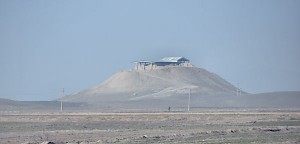Tepe Nush-e Jan
Q69133568Tepe Nush-e Jan: Iron Age settlement in western Iran, probably a Median fortress/sanctuary.

The ancient Iron Age settlement known as Tepe Nush-e Jan can be found 50 kilometers south of modern Hamadan (ancient Ecbatana). It is often described as a Median town, and perhaps rightly so. However, there is a problem. According to written sources, the Medes were masters of large parts of Iran and Turkey, so we would expect to find more or less the same objects in the centers of government.
However, so far, it has been impossible to identify the objects that represent the Median state. The empire of the Medes is not an archaeological fact (yet), but exists only as something mentioned by Herodotus and texts based (directly or indirectly) upon this entertaining Greek author, like the Biblical book of Daniel. A possible explanation for this discrepancy is that the Medians remained nomadic, and that Herodotus has projected aspects of the Achaemenid Empire - a real, fully developed state - backwards.

Yet, there must have been a Median civilization, and it must have looked like Tepe Nush-e Jan, which was excavated in 1967-1974 and has been made accessible more recently. The complex was erected out of mud brick and consisted of
- a multi-storied fort with heavy walls and large store rooms;
- several palace-like rooms, called the "old western building";
- a hall of 20x16 meter with twelve columns (which the excavators have playfully labeled "the apadana");
- a water tunnel that started in the hall;
- a cross-shaped building that has been interpreted as a fire sanctuary - probably the oldest example of this type of building. A 14C-dating suggests that it was built in 723±220 BCE.

The buildings were erected in the second half of the eighth century and stood on a high, partly natural hill (not unlike contemporary Urartian Iron Age settlements, e.g., Çavustepe in Turkey or Bastam in NW-Iran). No traces of a village have been identified near Tepe Nush-e Jan, which confirms that the inhabitants were nomads; the building of the complex appears to have been something of an innovation. Assyrian pressure may have been the reason for building the fort.
The site was abandoned at the beginning of the sixth century. Possibly, the summit was used as a look-out post during the Achaemenid age and - after a second gap - during the first century BCE.
Getting there
The walls of the complex are almost eight meters high, and because they are situated on a hill that rises about thirty-seven meters above the fertile plain, Tepe Nush-e Jan is easy to see from the Hamadan-Malayer road. The site is 60 km south of Hamaden and 20 north of Malayer.
Literature
- David Stronach, "Tepe Nush-e Jan, a Mound in Media", in: The Bulletin of the Metropolitan Museum of Art, 28 (1968)
- David Stronach, "Tepe Nush-e Jan", in: Iran 13 (1974)
- David Stronach and Michael Roaf, "Tepe Nush-e Jan" in: Iran 12 (1973)






